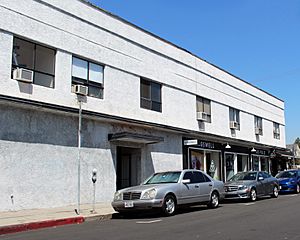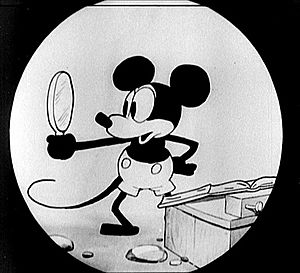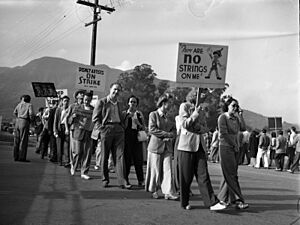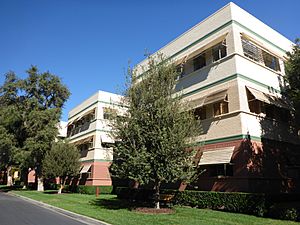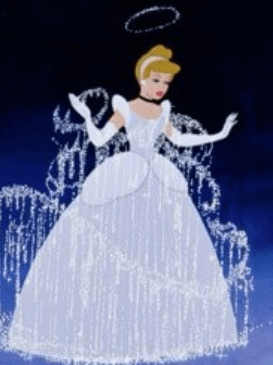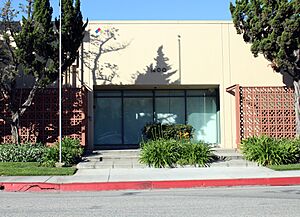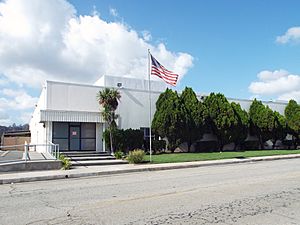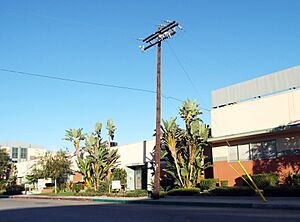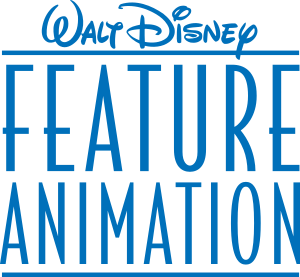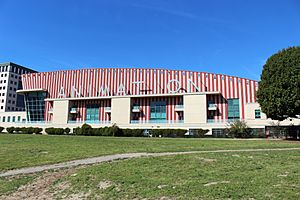Walt Disney Animation Studios facts for kids
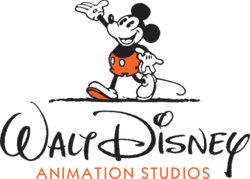
Logo used since 2007
|
|
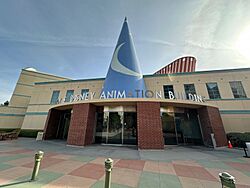
The studio's headquarters at the Roy E. Disney Animation Building in Burbank, pictured in 2023
|
|
|
Formerly
|
|
|---|---|
| Division | |
| Industry | |
| Predecessor | Laugh-O-Gram Studio |
| Founded | October 16, 1923 |
| Founders | |
| Headquarters | 2100 West Riverside Drive,
,
U.S.
|
|
Key people
|
Jared Bush (CCO)
|
| Products |
|
| Parent | Walt Disney Studios |
Walt Disney Animation Studios (WDAS), also known as Disney Animation, is an American animation studio. It creates animated movies and short films for The Walt Disney Company. The studio's logo shows a scene from its first sound cartoon, Steamboat Willie (1928).
Brothers Walt Disney and Roy O. Disney started the studio on October 16, 1923. It is the oldest animation studio in the world. Today, it is part of Walt Disney Studios. Its main office is in Burbank, California. Since it began, the studio has made 63 feature films. These range from Snow White and the Seven Dwarfs (1937) to Moana 2 (2024). Snow White was the first hand-drawn animated feature film ever made. The studio has also created hundreds of short films.
The studio started as Disney Brothers Cartoon Studio in 1923. It changed its name to Walt Disney Studio in 1926. In 1929, it became Walt Disney Productions. At first, the studio only made short films. But in 1934, it began making feature films. This led to Snow White and the Seven Dwarfs in 1937. In 1986, the company changed its name to The Walt Disney Company. The animation studio became Walt Disney Feature Animation. Its current name, Walt Disney Animation Studios, was adopted in 2006. This happened after Disney bought Pixar Animation Studios.
Many people think of Disney Animation when they hear the word "animation." The studio was known as the best American animation studio for a long time. It created many techniques and ideas that became standard in traditional animation. The studio also started using storyboards. Storyboards are now common in movies, TV shows, and video games. Disney's animated movies are some of its most famous creations. Characters like Mickey Mouse, Minnie Mouse, Donald Duck, Daisy Duck, Goofy, and Pluto are famous worldwide. They are also mascots for The Walt Disney Company.
Some of the studio's films have earned a lot of money. Frozen (2013), Frozen 2 (2019), and Moana 2 (2024) are among the 50 highest-grossing films of all time. Frozen 2 is the fourth-highest-grossing animated feature film of all time.
By 2013, the studio was not developing any new hand-drawn animated films. Their computer-animated films were doing better at the box office. Many hand-drawn animators were laid off. However, the studio stated in 2019 and 2023 that they are open to new hand-drawn projects. In April 2022, animator Eric Goldberg confirmed plans to return to hand-drawn animation.
Contents
- History of Disney Animation
- Starting the Studio (1923–1929)
- Growing with Snow White (1929–1940)
- New Films and World War II (1940–1948)
- New Features and Changes (1948–1966)
- Changes and Challenges (1966–1984)
- New Beginnings and Success (1984–1994)
- The Disney Renaissance (1989–1994)
- Later Renaissance and Challenges (1994–2005)
- New Leadership and Revival (2005–2019)
- Recent Years (2019–present)
- Production Logo
- Studio Information
- Films and Shows
- More About Disney Animation
- See also
History of Disney Animation
Starting the Studio (1923–1929)
Walt Disney and Roy O. Disney were brothers from Kansas City, Missouri. They started Disney Brothers Cartoon Studio in Los Angeles in 1923. Their first projects were silent Alice Comedies short films. These films mixed a real child actress with animated characters.
The Disney brothers first worked in their uncle's garage. In October 1923, they officially opened their studio in a small office. They moved to a bigger office in February 1924. In 1925, Disney found a new location at 2719 Hyperion Avenue. This became known as the Hyperion Studio. In January 1926, the studio moved there and changed its name to Walt Disney Studio.
Later, Walt Disney tried to renew his contract for the Oswald the Lucky Rabbit cartoons. But the distributor wanted to pay Disney less. Disney refused. Since Universal owned the rights to Oswald, the distributor started his own studio to make Oswald cartoons. Most of Disney's staff left to work for the new studio.
While his staff finished the Oswald cartoons, Disney and his main animator Ub Iwerks secretly worked on a new character. This character was Mickey Mouse. The first two Mickey Mouse cartoons, Plane Crazy and The Galloping Gaucho, were shown in 1928. For the third Mickey cartoon, Steamboat Willie, Disney added sound. This was Disney's first cartoon with synchronized sound. It was a huge hit when it came out in November 1928. The Mickey Mouse sound cartoons quickly became very popular in the United States.
A second series of sound cartoons, Silly Symphonies, began in 1929 with The Skeleton Dance. These cartoons also had music and animation by Iwerks.
Growing with Snow White (1929–1940)
In 1929, Disney's animation company became Walt Disney Productions. It signed a new deal with Columbia Pictures. Later, in 1932, Disney signed a deal with Technicolor. This allowed them to use a new 3-strip color film process. This process made colors look much richer. The first film in full Technicolor was the Silly Symphony cartoon Flowers and Trees. It was a big success. After this, all Silly Symphonies were made in Technicolor.
By the early 1930s, Walt Disney realized that good stories were key to animated films. He created a special "story department" with storyboard artists. Their job was to develop exciting stories. With strong characters and a great story, the 1933 Technicolor Silly Symphony cartoon Three Little Pigs became a huge hit. Its song, "Who's Afraid of the Big Bad Wolf?", was very popular.
In 1934, Walt Disney announced his plan to make his first animated feature film. Many in the film industry made fun of it, calling it "Disney's Folly." But Disney went ahead with Snow White and the Seven Dwarfs. This became the first animated feature film in English and Technicolor. The studio grew a lot during its production. Animators, artists, and new college graduates joined to work on the film. Training classes were held, teaching many techniques that became standard in traditional animation. Silly Symphonies like The Goddess of Spring (1934) and The Old Mill (1937) were used to try out new techniques. These included animating realistic human figures and using the multiplane camera. This camera made animated scenes look more three-dimensional.
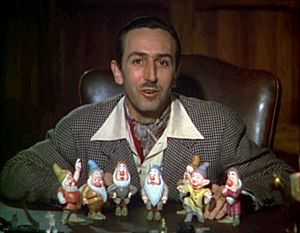
Snow White and the Seven Dwarfs cost $1.4 million to make. This was a lot of money back then. But it was a huge success when it came out in February 1938. It earned over $8 million at first. This made it one of the highest-grossing films of its time.
While Snow White was being made, work continued on Mickey Mouse and Silly Symphonies shorts. Mickey Mouse cartoons started using Technicolor in 1935. New characters like Pluto, Donald Duck, and Goofy joined the series. By 1940, Donald, Goofy, and Pluto had their own cartoon series. The Silly Symphonies series, which won seven Academy Awards, ended in 1939.
New Films and World War II (1940–1948)
The success of Snow White allowed Disney to build a new, larger studio in Burbank. This is where The Walt Disney Company is still located today.
The studio then made new animated features. The first was Pinocchio, released in February 1940. Pinocchio did not make a lot of money at first. But it was praised by critics. It won two Academy Awards for Best Original Song and Best Original Score. This was a first for the studio.
Fantasia, an experimental film with orchestral music, came out in November 1940. It cost $2 million to make. Even though it earned money, the special sound system called Fantasound was very expensive to install. This made Fantasia lose money. Despite this, Fantasia received two special Academy Awards in 1942. One was for its innovative Fantasound system.
Many of the animators on these films were part of a special group Walt Disney called the "Nine Old Men." These included Frank Thomas, Ollie Johnston, and Milt Kahl. They also directed and produced films.
A difficult strike happened in May 1941. It was resolved later that year. The strike caused many animators to leave the studio. Some of them went on to start other animation studios.
Dumbo, which was being made during the strike, came out in October 1941. It was a financial success. It cost $950,000 to make, much less than Snow White or Pinocchio. Dumbo was the first Disney animated film finished at the new Burbank studio. In August 1942, Bambi was released. Like Pinocchio and Fantasia, it did not do well at the box office at first.
Making full-length animated features stopped for a while after Bambi. This was because of financial issues and World War II. Films like Peter Pan and Alice in Wonderland were put on hold. During World War II, the studio helped the U.S. military. It housed soldiers and made training and propaganda films. From 1942 to 1943, 95 percent of the studio's animation was for the military. Disney also made Victory Through Air Power (1943), a live-action/animated military film. They also made two films from shorts about Latin American culture: Saludos Amigos (1942) and The Three Caballeros (1944).
Saludos Amigos and The Three Caballeros started a trend of "package films" in the 1940s. These were lower-budget films made of several animated shorts. Examples include Make Mine Music (1946) and Fun and Fancy Free (1947). The studio also made films like Song of the South (1946) and So Dear to My Heart (1948). These mixed live-action stories with animated parts. Song of the South is now controversial and not available on Disney+. Short films continued to be made, featuring characters like Donald Duck, Goofy, and Pluto.
Disney also started re-releasing its older films. Snow White was re-released in 1944, Pinocchio in 1945, and Fantasia in 1946. This began a tradition of reissuing Disney films every seven years.
New Features and Changes (1948–1966)
In 1948, Disney returned to making full-length features with Cinderella. This film was based on the fairy tale. It cost almost $3 million to make. The studio's future depended on its success. When Cinderella came out in 1950, it was a huge hit. Its profits allowed Disney to keep making animated films throughout the 1950s. After Cinderella's success, work restarted on Alice in Wonderland, Peter Pan, and Lady and the Tramp. A new project, Sleeping Beauty, also began.
Alice in Wonderland (1951) did not do very well. But Peter Pan (1953) was a commercial success. In 1955, Lady and the Tramp was released. It earned more money than any Disney animated film since Snow White. Lady and the Tramp was Disney's first widescreen animated feature. It was also the first Disney animated film released by Disney's own distribution company, Buena Vista Distribution.
By the mid-1950s, Walt Disney was focusing on new projects. These included live-action films, television, and the Disneyland theme park. The "Nine Old Men" animators took over much of the animated film production. This caused delays in making Sleeping Beauty, which finally came out in 1959. It was Disney's most expensive film at $6 million. Despite being a high-grossing film, its high costs led to the studio losing money in 1960. This resulted in many layoffs.
By the end of the 1950s, Disney was making fewer short films. Many of the shorts staff moved to work on TV shows like The Mickey Mouse Club. Other studios like Metro-Goldwyn-Mayer cartoon studio and Warner Bros. Cartoons started winning more awards for their shorts. The last regular Disney short of this era was It's Tough to Be a Bird in 1969. After that, Disney shorts were made only sometimes.
Even with layoffs and Walt Disney's focus on other areas, animated feature production continued. In 1961, the studio released One Hundred and One Dalmatians. This film made popular the use of xerography. This process allowed animation drawings to be copied directly onto clear sheets. This created a new, scratchier art style seen in Disney films until the 1980s. The film was a success.
Walt Disney helped found the California Institute of the Arts (CalArts). This school offered an animation program. Many future Disney animators studied there.
The Sword in the Stone was released in 1963. A Winnie-the-Pooh featurette, Winnie the Pooh and the Honey Tree, came out in 1966. More Pooh featurettes followed.
Walt Disney passed away in December 1966. Ten months later, the studio's next film, The Jungle Book, was released. The film was a success.
Changes and Challenges (1966–1984)
After Walt Disney's death, Wolfgang Reitherman continued to produce and direct the studio's films. He made sure the studio kept making money. He focused on creating family-friendly films.
In the 1970s, the studio released The Aristocats. This was the last film Walt Disney had approved. In 1971, Roy O. Disney passed away. The next film, Robin Hood (1973), was made with a smaller budget. Both films had moderate success.
The Rescuers, released in 1977, was a big success. It received good reviews and earned a lot of money. It was the most successful Disney animated film since The Jungle Book.
New animators like Don Bluth, Ron Clements, John Musker, and Glen Keane joined the studio. They were trained by older animators. In September 1979, Bluth and others left Disney. They started their own studio, Don Bluth Productions. This studio became a main competitor to Disney in the 1980s.
The Fox and the Hound was released in 1981. It was considered a financial success. Work continued on The Black Cauldron. This film was meant to appeal to older audiences. It also showed off the talents of the new animators. Some of these artists, like John Lasseter and Tim Burton, later became famous outside of Disney. Lasseter was fired for pushing for computer animation. He later led Pixar. Burton was fired after making a short film. He became a well-known director.
In 1983, Ron W. Miller, Walt Disney's son-in-law, created Walt Disney Pictures. Future animated films would be released under this name.
New Beginnings and Success (1984–1994)
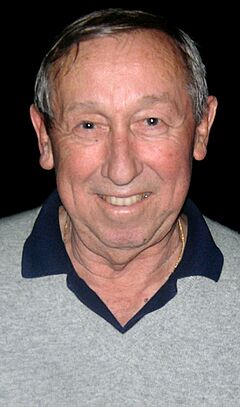
In 1984, Roy E. Disney, Walt's nephew, helped bring in new leaders for the company. Michael Eisner became the new CEO. The Black Cauldron (1985) was released. It was the studio's most expensive film at $44 million. But it did not do well. This put the animation department's future at risk.
Michael Eisner thought about closing the animation studio. But Roy E. Disney stepped in. He offered to lead the animation division and improve it. Roy E. Disney appointed Peter Schneider to manage the animation studio.
In 1985, the animation department moved to new buildings in Glendale, California. The first film made at the new location was The Great Mouse Detective (1986). It was a success. However, Don Bluth's film An American Tail (1986) earned more money.
The studio leaders decided to release a new animated film every year. The first film on this faster schedule was Oliver & Company (1988). It had famous voice actors and pop songs. Oliver & Company earned more money in the U.S. than any animated film before it.
In 1988, Disney also bought an animation studio in Australia.
Disney worked with Steven Spielberg and animator Richard Williams to make Who Framed Roger Rabbit (1988). This film mixed live-action and animation. It featured characters from different studios. Roger Rabbit was a big success. It won three Academy Awards and helped renew interest in American animation.
The Disney Renaissance (1989–1994)
A second Disney animation studio opened in Florida in 1989. That same year, the studio released The Little Mermaid. This film was a huge success. It earned $84 million in North America, a record for the studio. It had songs by Broadway songwriters Alan Menken and Howard Ashman. The Little Mermaid won two Academy Awards.
The Little Mermaid brought new interest to animation and musical films. It was also the first film to use Disney's Computer Animation Production System (CAPS). This system, developed with Pixar, helped integrate computer-generated imagery (CGI) and improve animation quality. The Little Mermaid was the first of many successful films during a period called the Disney Renaissance. During this time, the studio also returned to making films with darker themes and scarier villains.
The Rescuers Down Under (1990) was Disney's first animated sequel. It was also the first film fully colored and composited using the CAPS system. However, it did not do as well as The Little Mermaid. The next film, Beauty and the Beast, was a huge critical and commercial success. It was nominated for six Academy Awards, including Best Picture. It won for Best Song and Best Original Score. Its $145 million box office set new records.
The success of these films set a pattern for future Disney movies in the 1990s. They were musical comedies with Broadway-style songs and exciting action. They also had lots of merchandise and promotions. New artists like Roger Allers, Rob Minkoff, and Glen Keane helped create these films.
Aladdin, released in November 1992, continued Disney's success. It earned $504 million worldwide and won two more Oscars. It featured songs by Menken, Ashman, and Tim Rice. It also starred the voice of Robin Williams. Aladdin helped start the trend of hiring famous actors for Disney characters.
In June 1994, Disney released The Lion King. This film was an all-animal story set in Africa. It had famous voice actors like James Earl Jones and Matthew Broderick. Songs were written by Tim Rice and Elton John. The Lion King earned $768 million worldwide. This is still a record for a traditionally-animated film. It also made millions from merchandise and music sales.
Aladdin and The Lion King were the highest-grossing films worldwide in their release years. Animation became a very important part of Disney's business. The California studio expanded. A new Disney Feature Animation building opened in Burbank in 1995. A studio in Paris, France, also became Walt Disney Feature Animation Paris. Disney also started making lower-cost direct-to-video sequels. The Return of Jafar (1994) was the first of these.
Disney was also involved in making Toy Story, the first fully computer-animated feature. Toy Story was made by Pixar and directed by former Disney animator John Lasseter. When it came out in 1995, it was a big hit. This led to Pixar signing a deal to make five more films with Disney.
The success of Disney's films also led other studios to create their own animation divisions.
Later Renaissance and Challenges (1994–2005)
In 1994, Jeffrey Katzenberg left Disney. He later helped start DreamWorks SKG. Its animation division became a main rival to Disney. In December 1994, the new Animation Building in Burbank was finished.
Not all films in the second half of the Renaissance were as successful. Pocahontas (1995) received mixed reviews. But it was still popular and earned $346 million worldwide. It won two Academy Awards for its music.
The Hunchback of Notre Dame (1996) was partly made at the Paris studio. It was Disney's darkest film. It earned $325 million worldwide.
Hercules (1997) earned $252 million worldwide. This was less than previous Disney films. The cost of making films was also increasing. Disney needed its new films to be popular for merchandise and theme park attractions. The production schedule was slowed down.
Mulan (1998) was the first film made mostly at the Florida studio. It received positive reviews and earned $305 million. Tarzan (1999) had a high cost of $130 million. It also received good reviews and earned $448 million. The Tarzan soundtrack by Phil Collins was very popular.
Fantasia 2000, a sequel to the 1940 film, premiered in December 1999. It was the first animated feature released in IMAX format. The film cost $90 million to make. It lost money for the studio.
In 1999, Peter Schneider left his role. Thomas Schumacher became the new president of Walt Disney Feature Animation. He was tasked with cutting costs. Many animators were laid off.
In October 1999, a special effects studio called Dream Quest Images merged with Disney's computer-graphics team. They formed a division called The Secret Lab. The Secret Lab made one film, Dinosaur, released in May 2000. It featured CGI dinosaurs with real backgrounds. The film earned $349 million, but this was less than expected. The Secret Lab closed in 2001.
The Emperor's New Groove was released in December 2000. It was a comedy that earned $169 million worldwide. Atlantis: The Lost Empire (2001) tried a new action-adventure style. It received mixed reviews and earned $186 million.
By 2001, computer-animated films from Pixar and DreamWorks were very successful. This led to the idea that hand-drawn animation was becoming old-fashioned. Disney laid off most of its hand-drawn animators in Burbank. The studio planned to focus on fully computer-animated films. The Paris studio also closed in 2003.
The remaining hand-drawn films, Treasure Planet and Home on the Range, continued production. Treasure Planet (2002) was a futuristic space story. It received good reviews but did not make much money.
The Burbank studio's 2D departments closed at the end of 2002. Hand-drawn animation continued at the Florida studio. Lilo & Stitch (2002) was a comedy-drama. It became a big hit, earning $273 million worldwide.
Disney also started releasing lower-budgeted sequels to older films. These were meant for video but sometimes released in theaters.
In 2003, David Stainton became the new president of Walt Disney Feature Animation. Under him, the Florida studio finished Brother Bear. It did not do as well as Lilo & Stitch. Disney closed the Florida studio on January 12, 2004. Home on the Range, released in April 2004, was also not a big success. Disney officially announced it would become a fully CGI studio.
In 2003, Roy E. Disney resigned from The Walt Disney Company. He started a campaign to remove Michael Eisner. One of his reasons was Eisner's handling of Feature Animation.
Talks between Eisner and Pixar CEO Steve Jobs about renewing their deal broke down in 2004. Disney announced it would start Circle 7 Animation. This division would make sequels to Pixar films.
In 2005, Disney released its first fully computer-animated feature, Chicken Little. It was a box office success, earning $315 million worldwide. But critics gave it mixed reviews. Later that year, Eisner announced he would resign. Bob Iger became his successor.
New Leadership and Revival (2005–2019)
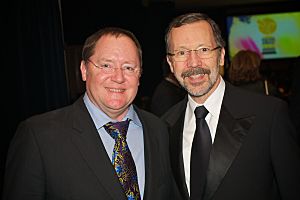
After Bob Iger became CEO, he believed Disney Animation needed new leadership. In January 2006, Disney announced it would buy Pixar for $7.4 billion. As a result, the Circle 7 studio was shut down. Most of its employees returned to Feature Animation. Toy Story 3 (2010) went back to Pixar's control.
Edwin Catmull and John Lasseter became president and Chief Creative Officer of both Feature Animation and Pixar. They decided not to close Feature Animation. They wanted to bring the studio back to its former glory. Lasseter and Catmull rehired many animators who had left. They also changed the studio's culture. They focused on letting filmmakers lead projects, rather than executives.
In 2007, Lasseter changed the studio's name to Walt Disney Animation Studios. He said it would make both traditional and computer-animated films.
The studio released Meet the Robinsons in 2007. It was its second all-CGI film. The next film, Bolt, was released in 2008. It received good reviews and was a moderate financial success.
The Princess and the Frog was the studio's first hand-drawn animated film in five years. It was released in 2009. It was a return to the musical-comedy style of the 1990s. The film received positive reviews. However, its box office performance was not as strong as hoped. This was partly due to competition from Avatar. It was also thought that the word "Princess" in the title might have limited its audience. Because of this, future Disney films about princesses were given more general titles. Rapunzel became Tangled, and The Snow Queen became Frozen.
In 2010, the studio released Tangled. This was a CGI adaptation of "Rapunzel". It was a big critical and commercial success. It earned $592 million worldwide. The hand-drawn film Winnie the Pooh followed in 2011. It received positive reviews. It is the studio's most recent hand-drawn feature film.
Wreck-It Ralph, released in 2012, was a critical and commercial success. It won many awards and earned $471 million worldwide. The studio also won its first Academy Award for a short film in 44 years with Paperman. This short used a new technique that blended hand-drawn and computer animation.
In 2013, the studio laid off some hand-drawn animators. But later that year, Frozen was released. It was a CGI musical film inspired by "The Snow Queen". It became a huge hit, earning over $1 billion worldwide. Frozen was the first Walt Disney Animation Studios film to win the Academy Award for Best Animated Feature. It also won multiple Academy Awards.
The studio's next film, Big Hero 6, came out in November 2014. It was a comedy-adventure film based on Marvel Comics. It received critical acclaim and won the Academy Award for Best Animated Feature. The film was shown with the short Feast, which also won an Academy Award.
In March 2016, the studio released Zootopia. This was a buddy-comedy film set in a world of talking animals. It was a critical and commercial success, earning over $1 billion worldwide. It also won the Academy Award for Best Animated Feature.
Moana, a fantasy-adventure film, was released in November 2016. It was another commercial and critical success. It earned over $600 million worldwide and received two Academy Award nominations.
In November 2017, John Lasseter took a leave of absence. Jennifer Lee was announced as his replacement as chief creative officer in June 2018. In November 2018, the studio released Ralph Breaks the Internet, a sequel to Wreck-It Ralph. It earned over $529 million worldwide.
Recent Years (2019–present)
In August 2019, Clark Spencer became president of Disney Animation. Jennifer Lee continued as chief creative officer.
Frozen 2, a sequel to Frozen, was released in November 2019. The film earned over $1 billion worldwide.
From 2020 to 2022, Disney Animation made a series of experimental shorts called Short Circuit for Disney+. During this time, Disney Animation also returned to hand-drawn animation for some shorts. In April 2022, Eric Goldberg confirmed plans to develop hand-drawn animated films and series again.
In December 2020, the studio announced it would expand into making television series for Disney+. These included Baymax! (a spin-off of Big Hero 6) and Zootopia+.
Raya and the Last Dragon, a fantasy-adventure film, was released in March 2021. Due to the COVID-19 pandemic, it was released in theaters and on Disney+ at the same time. It earned over $130 million at the box office. It became a very popular film on streaming.
In August 2021, Disney Animation opened a new studio in Vancouver. This studio works on animation for Disney+ series and specials.
In November 2021, the studio released Encanto, a musical-fantasy film. It was released in theaters for 30 days, then on Disney+. Although it did not make a lot of money in theaters, it became very popular on Disney+. The film won the Academy Award for Best Animated Feature.
In November 2022, the studio released the action-adventure film Strange World. It received positive reviews but did not do well at the box office.
By 2023, the studio started a new program for hand-drawn animators. That same year, the short film Once Upon a Studio was released to celebrate Disney's 100th anniversary. It won an award for Outstanding Animated Short Form Program.
The 2D/CG hybrid musical-fantasy film Wish was released in November 2023. It was inspired by Disney's 100th anniversary. It received mixed reviews and lost money.
In September 2024, Jennifer Lee stepped down as chief creative officer. She returned to full-time filmmaking to direct and write Frozen 3 and write and executive produce Frozen 4. Jared Bush was named her successor.
The studio released the sequel Moana 2 in November 2024. It was originally planned as a Disney+ series. The film received mixed reviews but was a commercial success, earning over $1 billion worldwide.
Production Logo
Until 2007, Walt Disney Animation Studios used the standard Walt Disney Pictures logo. Starting with the 2007 film Meet the Robinsons, an on-screen production logo based on Steamboat Willie was added. This logo has had different versions, like a pixelated one for Wreck-It Ralph (2012).
Steamboat Willie became part of the public domain on January 1, 2024. The logo is still in use.
Studio Information
Leadership Team
Current Leaders
- Jared Bush, Chief Creative Officer (since September 2024)
- Clark Spencer, President (since August 2019)
Past Leaders
- Andrew Millstein, President (November 2014 – July 2019)
- Edwin Catmull, President (June 2007 – July 2019)
- David Stainton, President (January 2003 – January 2006)
- Thomas Schumacher, President (January 1999 – December 2002)
- Peter Schneider, President (1985 – January 1999)
- John Lasseter, Chief Creative Officer (January 2006 – June 2018)
- Jennifer Lee, Chief Creative Officer (June 2018 – September 2024)
- Roy E. Disney, Chairman (1984 – 2003)
Studio Locations
Since 1995, Walt Disney Animation Studios has been based in the Roy E. Disney Animation Building in Burbank, California. This building is across the street from the main Walt Disney Studios. The lobby of the Disney Animation Building has a large version of the sorcerer's hat from Fantasia (1940). Because of this, the building is sometimes called the "hat building."
Before the mid-1990s, Disney Animation worked out of old hangars and offices in Glendale, California. The Disneytoon Studios unit was also in Glendale. Disney Animation's archive, called the Animation Research Library, is also in Glendale. It holds over 64 million pieces of animation artwork dating back to 1924.
In the past, there were other animation studios in Paris, France, and Bay Lake, Florida. The Paris studio closed in 2002. The Florida studio closed in 2004.
After Roy E. Disney passed away in 2009, the Burbank headquarters was renamed the Roy E. Disney Animation Building in May 2010.
In November 2014, the Roy E. Disney Animation Building began a 16-month renovation. Employees temporarily moved to other Disney buildings. The renovation was finished in October 2016.
Films and Shows
Feature Films
Walt Disney Animation Studios has made animated films using different techniques. These include traditional animation, computer animation, and a mix of both. They have also combined animation with live-action scenes. Their first film, Snow White and the Seven Dwarfs, came out on December 21, 1937. Their most recent film, Moana 2, was released on November 27, 2024.
Since Chicken Little (2005), most of their films have cost between $150–175 million. Tangled (2010) is the studio's most expensive film, with a budget of $260 million.
Upcoming Films
The studio's next film is the sequel Zootopia 2. It is planned for release on November 26, 2025. The sequel Frozen 3 is scheduled for November 24, 2027.
Short Films
Since the 1920s, Walt Disney Animation Studios has made many famous short films. These include the Mickey Mouse cartoons and the Silly Symphonies series. Many of these shorts helped the studio try out new technologies. For example, they experimented with synchronized sound in Steamboat Willie (1928). They also used the three-strip Technicolor process in Flowers and Trees (1932). Other innovations included the multiplane camera in The Old Mill (1937) and the xerography process in Goliath II (1960). They also explored hand-drawn/CGI hybrid animation in films like Paperman (2012) and Get a Horse! (2013).
Television Shows
Walt Disney Animation Studios announced in 2020 that it would start making television series. These shows were for Disney+. However, on March 3, 2025, the studio announced that all TV series in production were stopped. The studio decided to focus only on making feature films for theaters.
| Title | Network | Original run | Notes |
|---|---|---|---|
| Short Circuit | Disney+ | 2020–22 | Shorts |
| Zenimation | 2020–21 | ||
| How to Stay at Home | 2021 | ||
| Olaf Presents | |||
| Baymax! | 2022 | TV series | |
| Zootopia+ | |||
| Iwájú | 2024 | TV series; co-production with Kugali Media and Cinesite |
Popular Film Series
This list includes film series and franchises that feature movies, short films, and TV shows. These were made by Walt Disney Animation Studios or other Disney animation units.
| Titles | Release dates |
|---|---|
| Mickey Mouse & Friends | 1928–present |
| Silly Symphonies | 1929–present |
| Snow White and the Seven Dwarfs | 1937–present |
| Pinocchio | 1940–present |
| Fantasia | 1940–2018 |
| Dumbo | 1941–2019 |
| Bambi | 1942–present |
| Make Mine Music | 1946–1954 |
| Cinderella | 1950–2015 |
| Alice in Wonderland | 1951–2024 |
| Peter Pan | 1953–present |
| Lady and the Tramp | 1955–2019 |
| Sleeping Beauty | 1959–present |
| 101 Dalmatians | 1961–present |
| Winnie the Pooh | 1966–present |
| The Jungle Book | 1967–present |
| The Rescuers | 1977–1990 |
| The Fox and the Hound | 1981–2006 |
| The Little Mermaid | 1989–present |
| Beauty and the Beast | 1991–present |
| Aladdin | 1992–present |
| The Lion King | 1994–present |
| Pocahontas | 1995–1998 |
| The Hunchback of Notre Dame | 1996–present |
| Hercules | 1997–present |
| Mulan | 1998–present |
| Tarzan | 1999–2005 |
| The Emperor's New Groove | 2000–2008 |
| Atlantis | 2001–2003 |
| Lilo & Stitch | 2002–present |
| Brother Bear | 2003–2006 |
| The Princess and the Frog | 2009–present |
| Prep & Landing | 2009–present |
| Tangled | 2010–present |
| Wreck-It Ralph | 2012–present |
| Frozen | 2013–present |
| Big Hero 6 | 2014–present |
| Zootopia | 2016–present |
| Moana | |
| Encanto | 2021–present |
Highest-Grossing Films
-
 Indicates films playing in theatres in the week commencing 12 December 2025.
Indicates films playing in theatres in the week commencing 12 December 2025.
| Rank | Title | Year | Box office gross |
|---|---|---|---|
| 1 | Frozen 2 | 2019 | $477,373,578 |
| 2 | Moana 2 | 2024 | $460,072,062 |
| 3 | The Lion King | 1994 | $422,783,777 |
| 4 | Frozen | 2013 | $400,738,009 |
| 5 | Zootopia | 2016 | $341,268,248 |
| 6 | Moana | $248,757,044 | |
| 7 | Big Hero 6 | 2014 | $222,527,828 |
| 8 | Beauty and the Beast | 1991 | $218,967,620 |
| 9 | Aladdin | 1992 | $217,350,219 |
| 10 | Ralph Breaks the Internet | 2018 | $201,091,711 |
| 11 | Tangled | 2010 | $200,821,936 |
| 12 | Wreck-It Ralph | 2012 | $189,422,889 |
| 13 | Snow White and the Seven Dwarfs | 1937 | $184,925,486 |
| 14 | Tarzan | 1999 | $171,091,819 |
| 15 | Lilo & Stitch | 2002 | $145,794,338 |
| 16 | One Hundred and One Dalmatians | 1961 | $144,880,014 |
| 17 | The Jungle Book | 1967 | $141,843,612 |
| 18 | Pocahontas | 1995 | $141,579,773 |
| 19 | Dinosaur | 2000 | $137,748,063 |
| 20 | Chicken Little | 2005 | $135,386,665 |
| 21 | Bolt | 2008 | $114,053,579 |
| 22 | The Little Mermaid | 1989 | $111,543,479 |
| 23 | The Princess and the Frog | 2009 | $104,400,899 |
| 24 | Bambi | 1942 | $102,247,150 |
| 25 | The Hunchback of Notre Dame | 1996 | $100,138,851 |
| Rank | Title | Year | Box office gross |
|---|---|---|---|
| 1 | Frozen 2 | 2019 | $1,453,683,476 |
| 2 | Frozen | 2013 | $1,280,802,282 |
| 3 | Moana 2 | 2024 | $1,057,727,242 |
| 4 | Zootopia | 2016 | $1,025,521,689 |
| 5 | The Lion King | 1994 | $979,046,652 |
| 6 | Moana | 2016 | $687,229,282 |
| 7 | Big Hero 6 | 2014 | $657,870,525 |
| 8 | Tangled | 2010 | $592,472,813 |
| 9 | Ralph Breaks the Internet | 2018 | $529,323,962 |
| 10 | Aladdin | 1992 | $504,050,219 |
| 11 | Wreck-It Ralph | 2012 | $471,222,889 |
| 12 | Tarzan | 1999 | $448,191,819 |
| 13 | Beauty and the Beast | 1991 | $438,656,843 |
| 14 | Snow White and the Seven Dwarfs | 1937 | $418,200,000 |
| 15 | The Jungle Book | 1967 | $378,000,000 |
| 16 | Dinosaur | 2000 | $349,822,765 |
| 17 | Pocahontas | 1995 | $346,079,773 |
| 18 | Bolt | 2008 | $328,015,029 |
| 19 | The Hunchback of Notre Dame | 1996 | $325,338,851 |
| 20 | Chicken Little | 2005 | $314,432,837 |
| 21 | Mulan | 1998 | $304,320,254 |
| 22 | One Hundred and One Dalmatians | 1961 | $303,000,000 |
| 23 | Lilo & Stitch | 2002 | $273,144,151 |
| 24 | The Princess and the Frog | 2009 | $270,997,378 |
| 25 | Bambi | 1942 | $267,447,150 |
More About Disney Animation
- The Walt Disney Company
- Disney's Nine Old Men
- 12 basic principles of animation
- Walt Disney Home Video (VHS)
- Walt Disney Treasures
- Disney Animation: The Illusion of Life
- Modern animation in the United States: Disney
- Animation studios owned by The Walt Disney Company
- Disneytoon Studios
- Circle Seven Animation
- Pixar
- Pixar Canada
- Fox Animation Studios
- Blue Sky Studios
- 20th Century Animation
- List of Disney theatrical animated feature films
- Disney Television Animation
- List of animation studios
Documentaries About Disney Animation
- A Trip Through the Walt Disney Studios (1937, short)
- The Reluctant Dragon (1941, a staged "mockumentary")
- Frank and Ollie (1995)
- Dream On Silly Dreamer (2005)
- Waking Sleeping Beauty (2009)
- Walt & El Grupo (2009)
- Howard (2018)
See also
 In Spanish: Walt Disney Animation Studios para niños
In Spanish: Walt Disney Animation Studios para niños


